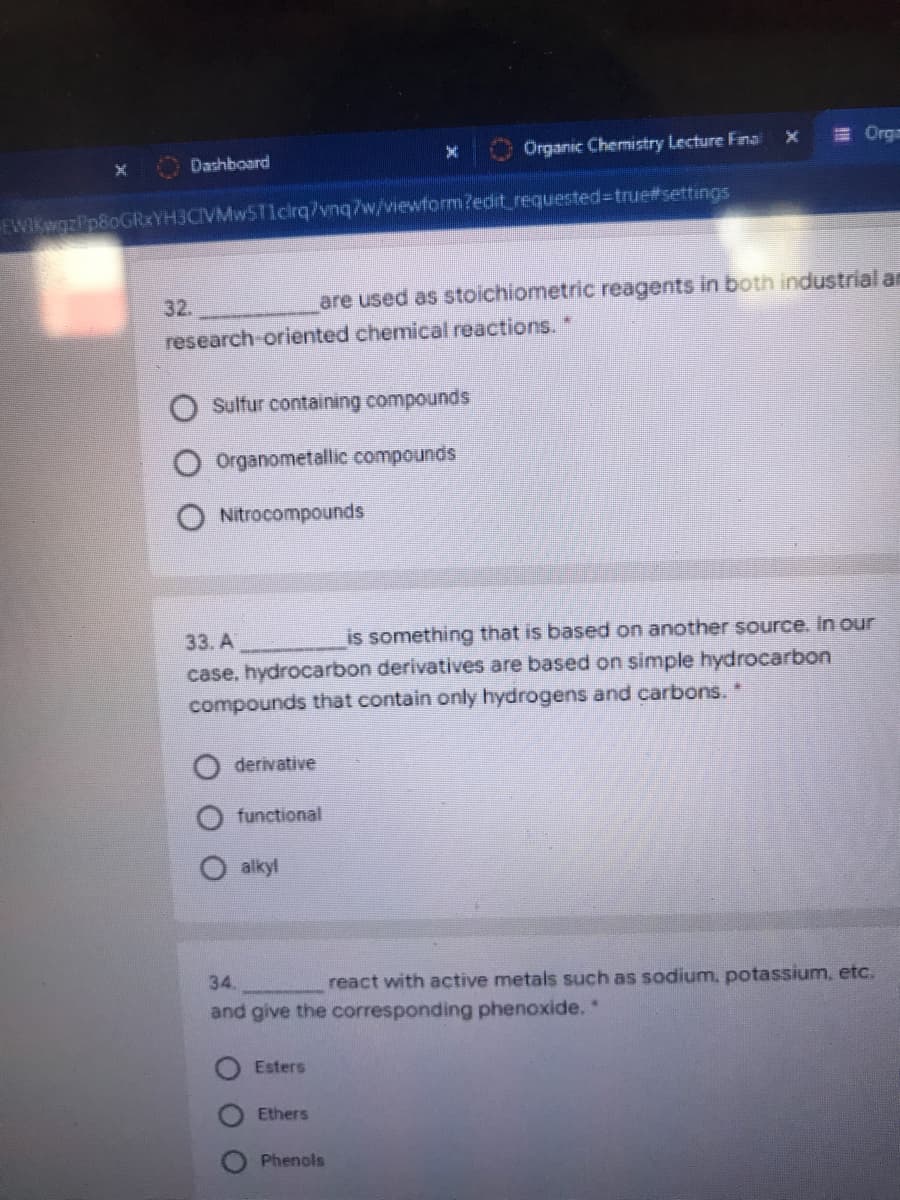32. are used as stoichiometric reagents in both industrial ar research-oriented chemical reactions. O Sulfur containing compounds Organometallic compounds Nitrocompounds 33. А is something that is based on another source. In our case, hydrocarbon derivatives are based on simple hydrocarbon compounds that contain only hydrogens and carbons. O derivative functional O alkyl 34. and give the corresponding phenoxide. react with active metals such as sodium, potassium, etc.
32. are used as stoichiometric reagents in both industrial ar research-oriented chemical reactions. O Sulfur containing compounds Organometallic compounds Nitrocompounds 33. А is something that is based on another source. In our case, hydrocarbon derivatives are based on simple hydrocarbon compounds that contain only hydrogens and carbons. O derivative functional O alkyl 34. and give the corresponding phenoxide. react with active metals such as sodium, potassium, etc.
Chemistry
10th Edition
ISBN:9781305957404
Author:Steven S. Zumdahl, Susan A. Zumdahl, Donald J. DeCoste
Publisher:Steven S. Zumdahl, Susan A. Zumdahl, Donald J. DeCoste
Chapter1: Chemical Foundations
Section: Chapter Questions
Problem 1RQ: Define and explain the differences between the following terms. a. law and theory b. theory and...
Related questions
Question

Transcribed Image Text:Organic Chemistry Lecture Final
E Orga
Dashboard
EWIKgzPp8oGRxYH3CIVMw5T1cirq/vnq7w/viewform?edit requested%-true#settings
32.
are used as stolchiometric reagents in both industrial an
research-oriented chemical reactions."
Sulfur containing compounds
Organometallic compounds
Nitrocompounds
33. A
is something that is based on another source. In our
case, hydrocarbon derivatives are based on simple hydrocarbon
compounds that contain only hydrogens and carbons.
O derivative
functional
alkyl
34.
react with active metals such as sodium, potassium, etc.
and give the corresponding phenoxide.*
Esters
Ethers
Phenols
Expert Solution
This question has been solved!
Explore an expertly crafted, step-by-step solution for a thorough understanding of key concepts.
Step by step
Solved in 2 steps with 2 images

Knowledge Booster
Learn more about
Need a deep-dive on the concept behind this application? Look no further. Learn more about this topic, chemistry and related others by exploring similar questions and additional content below.Recommended textbooks for you

Chemistry
Chemistry
ISBN:
9781305957404
Author:
Steven S. Zumdahl, Susan A. Zumdahl, Donald J. DeCoste
Publisher:
Cengage Learning

Chemistry
Chemistry
ISBN:
9781259911156
Author:
Raymond Chang Dr., Jason Overby Professor
Publisher:
McGraw-Hill Education

Principles of Instrumental Analysis
Chemistry
ISBN:
9781305577213
Author:
Douglas A. Skoog, F. James Holler, Stanley R. Crouch
Publisher:
Cengage Learning

Chemistry
Chemistry
ISBN:
9781305957404
Author:
Steven S. Zumdahl, Susan A. Zumdahl, Donald J. DeCoste
Publisher:
Cengage Learning

Chemistry
Chemistry
ISBN:
9781259911156
Author:
Raymond Chang Dr., Jason Overby Professor
Publisher:
McGraw-Hill Education

Principles of Instrumental Analysis
Chemistry
ISBN:
9781305577213
Author:
Douglas A. Skoog, F. James Holler, Stanley R. Crouch
Publisher:
Cengage Learning

Organic Chemistry
Chemistry
ISBN:
9780078021558
Author:
Janice Gorzynski Smith Dr.
Publisher:
McGraw-Hill Education

Chemistry: Principles and Reactions
Chemistry
ISBN:
9781305079373
Author:
William L. Masterton, Cecile N. Hurley
Publisher:
Cengage Learning

Elementary Principles of Chemical Processes, Bind…
Chemistry
ISBN:
9781118431221
Author:
Richard M. Felder, Ronald W. Rousseau, Lisa G. Bullard
Publisher:
WILEY